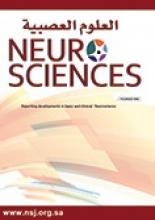Abstract
OBJECTIVE: The objective of this study was to determine the pattern of muscle weakness in patients with Guillain-Barre Syndrome.
METHODS: In a cross-sectional study, 50 Iraqi patients aged one to 60 years diagnosed with Guillain-Barre Syndrome according to Asbury criteria, admitted in 5 Neurological Centers in Baghdad, Iraq between October 1997 and October 1999, were studied for pattern of muscle weakness by clinical evaluation of power using scale from 0-5.
RESULTS: In 80% of patients, muscle weakness started in lower limbs while at presentation 4 limb weakness was the most frequent (96%). It was found that the upper extremity weakness was mainly distal in 73% of patients, while lower extremity weakness was mainly proximal in 68%. Weakness in extremities associated with cranial nerve involvement occurred in 72% of patients. Trunk muscles were involved in 34%. Various modes of spread of muscle weakness were seen in this study but the ascending variety was the most common occurring in 78% of patients and it was characterized by upward spread, however, contiguous parts of the body were not always successively involved.
CONCLUSION: Upper extremity weakness was mainly distal while lower extremity weakness was mainly proximal and there is predilection for trunk muscle involvement that is quite unusual in other types of polyneuropathy. Therefore, all patients with suspected Guillain-Barre Syndrome should be examined carefully for pattern of muscle weakness in extremities, which may be helpful in differential diagnosis especially in early stages of the disease.
- Copyright: © Neurosciences
Neurosciences is an Open Access journal and articles published are distributed under the terms of the Creative Commons Attribution-NonCommercial License (CC BY-NC). Readers may copy, distribute, and display the work for non-commercial purposes with the proper citation of the original work.






